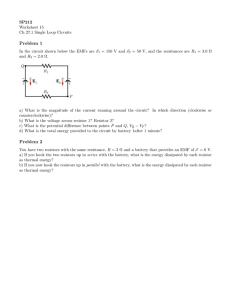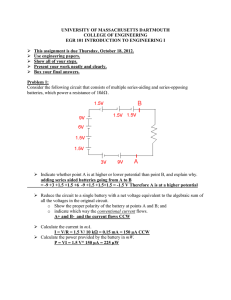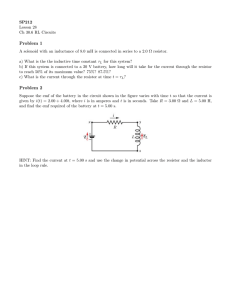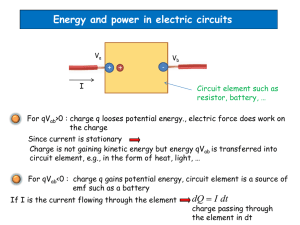PH203 Chapter 22 Solutions
advertisement
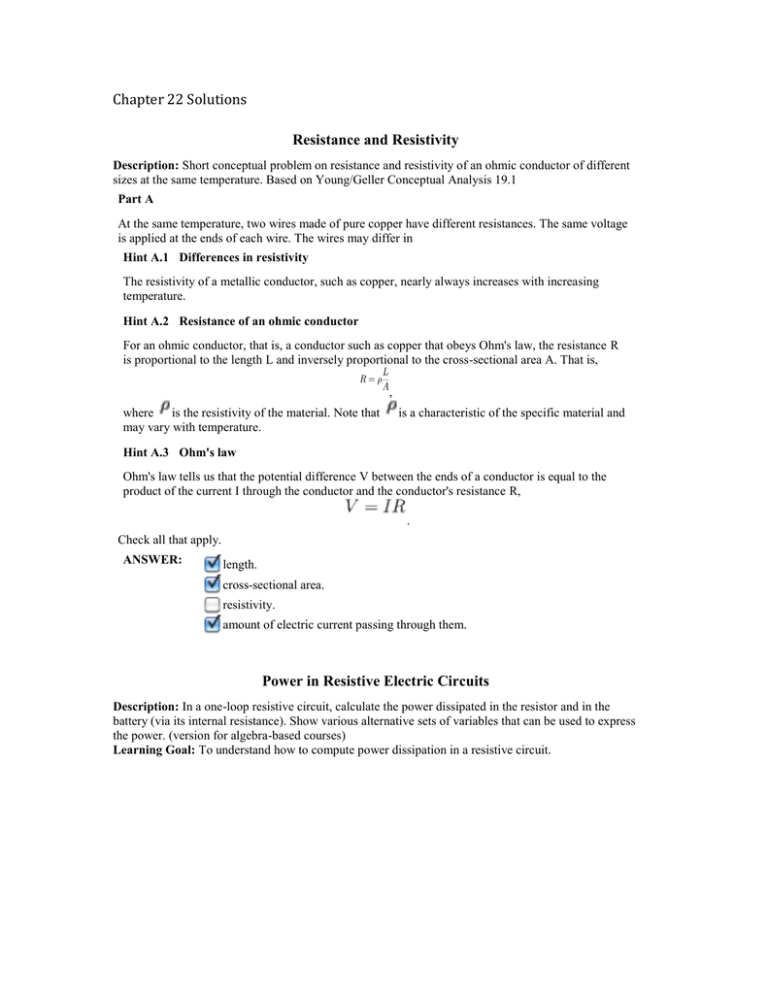
Chapter 22 Solutions Resistance and Resistivity Description: Short conceptual problem on resistance and resistivity of an ohmic conductor of different sizes at the same temperature. Based on Young/Geller Conceptual Analysis 19.1 Part A At the same temperature, two wires made of pure copper have different resistances. The same voltage is applied at the ends of each wire. The wires may differ in Hint A.1 Differences in resistivity The resistivity of a metallic conductor, such as copper, nearly always increases with increasing temperature. Hint A.2 Resistance of an ohmic conductor For an ohmic conductor, that is, a conductor such as copper that obeys Ohm's law, the resistance R is proportional to the length L and inversely proportional to the cross-sectional area A. That is, , where is the resistivity of the material. Note that may vary with temperature. is a characteristic of the specific material and Hint A.3 Ohm's law Ohm's law tells us that the potential difference V between the ends of a conductor is equal to the product of the current I through the conductor and the conductor's resistance R, . Check all that apply. ANSWER: length. cross-sectional area. resistivity. amount of electric current passing through them. Power in Resistive Electric Circuits Description: In a one-loop resistive circuit, calculate the power dissipated in the resistor and in the battery (via its internal resistance). Show various alternative sets of variables that can be used to express the power. (version for algebra-based courses) Learning Goal: To understand how to compute power dissipation in a resistive circuit. The circuit in the diagram consists of a battery with EMF E, a resistor with resistance R, an ammeter, and a voltmeter. The voltmeter and the ammeter (labeled V and A, respectively) can be considered ideal; that is, their resistances are infinity and zero, respectively. The current in the resistor is I, and the voltage across it is V. The internal resistance of the battery r int is not zero. Part A What is the ammeter reading I? Express your answer in terms of E , R, and r int. ANSWER: = Note that the resistances of the ammeter and voltmeter do not appear in the answer. That is because these two circuit elements are "ideal." The voltmeter has infinite resistance, so no current flows through it. The ammeter has zero resistance, so there is no voltage drop as current flows through it. Part B What is the voltmeter reading V? Hint B.1 Find the potential difference across the internal resistance What is the change in potential V int across the battery? Express your answer in terms of current I and the resistance R. ANSWER: = Substitute for I in terms of the variables asked for. Also add in any other contributions to the voltage measured by the voltmeter, with correct signs. Express your answer in terms of E , R, and r int . ANSWER: = In the following parts, you will express the power dissipated in the resistor of resistance R using three different sets of variables. Part C What is the power Pr dissipated in the resistor? Express your answer in terms of I and V. ANSWER: = Part D Again, what is the power Pr dissipated in the resistor? This time, express your answer in terms of one or more of the following variables: I, r int, and R . ANSWER: = Part E For the third time, what is the power Prdissipated in the resistor? Express your answer in terms of one or more of the following variables: E, r int , and R. ANSWER: = Power Dissipation in Resistive Circuit Conceptual Question Description: Short conceptual problem related to power dissipation in resistive circuits. A single resistor is wired to a battery as shown in the diagram below. Define the total power dissipated by this circuit as P. Now, a second identical resistor is wired in series with the first resistor as shown in the second diagram to the left . Part A What is the power, in terms of P, dissipated by this circuit? Hint A.1 How to find the power dissipated by a circuit The power dissipated by a circuit (or by an element in a circuit) is defined by the relation . If the circuit consists of resistors, we can combine this relation with Ohm's law, , to yield two alternate versions of the power formula: and . Because several circuit parameters can be changing simultaneously, it is easiest to use the formula in which only one of the terms is changing for your situation. This makes it much easier to determine the power dissipated in a resistive circuit. Hint A.2 Effect of adding a resistor in series Adding a resistor in series affects both the total resistance and total current in a circuit. Combining an understanding of these changes with the appropriate version of the power formula should allow you to answer this question. Express your answer in terms of . ANSWER: The second resistor is now removed from the circuit and rewired in parallel with the original resistor as shown in the schematic to the left Part B What is the power, in terms of , dissipated by this circuit? Hint B.1 How to find the power dissipated by a circuit The power dissipated by a circuit (or by an element in a circuit) is defined by the relation . If the circuit consists of resistors, we can combine this relation with Ohm's law, , to yield two alternate versions of the power formula: and . Because several circuit parameters can be changing simultaneously, it is easiest to use the formula in which only one of the terms is changing for your situation. This makes it much easier to determine the power dissipated in a resistive circuit. Hint B.2 Effect of adding a resistor in parallel Adding a resistor in parallel affects both the total resistance and current in a circuit. Combining an understanding of these changes with the appropriate version of the power formula should allow you to answer this question. Express your answer in terms of . ANSWER: ± Resistance of a Heater Description: ± Includes Math Remediation. Numerical problem on current and resistance of a heater, and finding how long it takes to heat a typical room. A 1500-W heater is designed to be plugged into a 120-V outlet. Part A What current will flow through the heating coil when the heater is plugged in? Hint A.1 Setting it up A heater can be modeled as a resistor. Hint A.2 Power Write an expression for P, the power dissipated through a resistor, in terms of V, the voltage across the resistor, and I, the current through the resistor. ANSWER: = Hint A.3 Finishing up Give an analytic expression for I in terms of V and P, the power. ANSWER: = Now plug in the values for P and V given in the problem. Express your answer for the current numerically, to three significant figures. ANSWER: = A Note that watts/volts has the correct units: Since and , then . Part B What is R , the resistance of the heater? Hint B.1 Which equation to use Now that you know I , you can easily find R using the relation V=IR. Express your answer numerically, to three significant figures. ANSWER: = ohms Part C How long does it take to raise the temperature of the air in a good-sized living room by and the density of air is ? Note that the specific heat of air is 1006 . Hint C.1 Mass of the air What is the mass of air contained within the room? Express your answer numerically, to three significant figures. ANSWER: = kg Hint C.2 How many joules What is the energy required to heat the air in the room ? Hint C.2.1 Formula for the energy required to heat an object The formula for the energy Q required to heat an object is where m is the mass of the object, c is its heat capacity and delta T is the temperature difference through which it is heated. Express your answer numerically in kiloJoules, to three significant figures. ANSWER: = kJ Express your answer numerically in minutes, to three significant figures. ANSWER: = minutes Actually, the heat capacity of the walls and other material in the room will generally exceed that of the air by several times, so an hour is a more reasonable time to heat the room by this much. PROBLEMS P22.1. Prepare: We will find the total charge that flows through the hair dryer and then divide it by the electron charge to find the number of electrons. Solve: Equation 22.2 is Q It. The amount of charge delivered is 60 s Q (10.0 A) 5.0 min 3000 C 1 min The number of electrons that flow through the hair dryer is Q 3000 C N 1.9 1022 e 1.60 1019 C Assess: This is an enormous amount of charge and is typical of such devices. P22.4. Reason: The relationship between current, charge, and time is I Q / t. Solve: The current is I Q / t 9.0 1012 C / (5.0 104 s) 1.8A Assess: We expect a small current due to very small flow of charge. P22.6. Prepare: Electric current, charge, and time are related by I Q/t. Solve: The current during the lightning strike is I Q /t 2.5 C/(2.0 104 s) 1.3 104 A. Assess: As expected, this is a large amount of current. P22.7. Prepare: Current is defined in terms of the amount of charge Q passing through a cross section of the wire in a time interval t : I Q/t. We are given that t 40 s 40 106 s and Q (1 013)(60 104 C) (087)(60 104 C) 522 104 C. Solve: I Q 522 104 C 13 A t 40 106 s Assess: 13 A is a fairly large current, but that is because capacitors discharge very quickly when the plates are connected with a wire. In the next chapter you will learn more specifically how the current decays in a discharging capacitor; it isn’t at a constant rate or in a linear fashion. But since all we’re asked for in this problem is the average current, we are already equipped to solve the problem. P22.15. Prepare: The emf is defined as the work done per unit charge by the charge escalator or the battery, so we will use Equation 22.4. Solve: Wchem 0.60 J 12 V q 0.050 C Assess: An emf of 12 V is reasonable for a battery. P22.18. Reason: The total potential difference is related to the potential difference for one cell by Vtotal NVcell . Solve: The number of cells needed to generate a total potential difference of 350 V is N Vtotal / Vcell 350 V / (0.110 V) 3180 cells. Assess: Since the potential difference per cell is small, we expect a large number of cells. P22.21. Prepare: The resistance of a wire may be determined by R L/A and the volume of the wire may be determined by V LA. We can use the expression for the volume to eliminate the area A in the expression for the resistivity and obtain R L /A L /(V /L) L2 /V . This expression informs us that the resistance of a wire varies as the square of the length if the volume remains constant. Solve: Since the length has doubled and the resistance varies as the length squared, the resistance of the stretched wire will be four times that of the unstretched wire. Rstretched 4Runstretched 4(0.010 ) 0.040 Assess: This is a reasonable resistance for wire. P22.22. Prepare: Resistivity is related to resistance, length, and cross-sectional area by R L / A, and the area is related to the width and thickness of the leaf by A WT. Solve: Combining these two expressions and solving for the resistivity, we obtain RA / L RWT / L (2.0 106 Ω)(2.5 102 m)(2.0 104 m) / (0.20 m) 50 Ω m Assess: This value for the resistivity is the same order of magnitude as other organic materials listed in Table 22.1. P22.24. Prepare: Resistance, current, and electric potential difference are related by Ohm’s law R V / I . Resistance, resistivity, length, and cross-sectional area are related by R L / A. Solve: Combining these two expressions and solving for the length of the wire obtain: L AV r 2V (12.5 105 m)2 (12 V) 8.7 m I I (4.0A)(1.7 108 Ω m) Assess: This is a reasonable length and can be sewn into a vest. P22.27. Prepare: The potential difference between the ends of a copper wire that carries a current can be obtained from Equation 22.6, I V /R, and Equation 22.8, R L/A. The resistivity of copper from Table 22.1 is 1.7 108 m. Solve: V IR I L (3.0 A)(1.7 108 m)(0.20 m) 13 mV A (0.5 103 m)2 Assess: Because copper’s resistivity is small, a potential difference of 13 mV across a 1.0 mm diameter and 20-cm long wire is reasonable. P22.28. Prepare: Resistance is related to resistivity, length, and cross-sectional area by R L / A. An electrical worker could have palms that are 10 cm by 12 cm or 1.2 10-2 m2. Solve: The resistance is R L / A (1.6 106 Ω m)(1.5 103 m) / (1.2 102 m2 ) 1.3 105 Ω Assess: This built-in safety factor is a good thing and a reasonable value. P22.40. Prepare: The relationships needed for this problem are P IV , P U / t and Q I t. Solve: (a) The power is P IV 360 W. (b) The total energy is U Pt 0.36 J. (c) The total charge that flows is Q I t 8.0 104 C. Assess: Given the electric potential, current, and time pulse, these are reasonable values for the power, total energy, and total charge. P22.41. Prepare: The dimensions of current times time (the rating printed on the battery) are not yet the dimensions of energy until we multiply by the dimensions of voltage. That is, in SI units, A s C, not J. However, if we multiply both sides by V then the result is an energy unit: A s V J. The upshot of this is that the battery rating mA h doesn’t tell us the energy capacity unless we also know the voltage of the battery. But we do know the voltage of the battery, so we proceed. Solve: 1 A 3600 s (450 mA h)(9 V) 14580 A s V 14580 J 15,000 J 1000 mA 1 h Assess: This is a reasonable amount of energy. Fatter batteries hold more chemicals and therefore more chemical potential energy, so a D-cell would have a higher mA h rating than a AA-cell (both at 1.5 V). The 9 V battery likely has six 1.5 V cells connected in series inside. P22.46. Prepare: This is an integrated problem and we will need to use information from previous chapters such as Equation 12.21, Q McT, to get the energy Q , and the equation for power, P Q/t, along with the equation for electrical power, P (V ) 2 /R (assuming the hot dogs are ohmic). We’ll solve the middle equation for t , insert P from the last equation and Q (which is energy, not charge) from the first. Known V 120 V R 150 M 0060 kg T 80C 20C 60C 60 K c 2500 J/(kg K) (from Table 12.4) Find t Solve: t Q McT (0060 kg)(2500 J/(kg K))(60 K) 94 s P (V )2/R (120 V)2/(150 ) Assess: The answer is just over one and a half minutes. This is not as fast as a modern microwave, but it was considered pretty quick before microwave ovens came along. Hot dogs cooked this way do not have a nice grilled look or flavor; they don’t smell as good as grilled hot dogs either. But kids will eat anything. It is especially in the integrated problems that we are likely to run into different uses of the same symbol. Recently we’ve been using Q as charge, but in this problem it is energy. The units deserve some attention. The kg and K cancel in the numerator. We’re left with J / V 2. Further, V/A and V J/C. J J V J V J C C 2 s 2 2 V V A AV A J A P22.55. Prepare: We assume the extension cord is ohmic so we can use V IR. We also use R L/A. We are given L 50 ft 152 m, I 10 A, and A r 2 (d /2)2 (13 mm/2)2 133 106 m2. We also look up the resistivity of copper in Table 22.1: Cu 17 108 m. Solve: Combine the two equations. (17 108 m)(152 m) L V IR I (10 A) 1 9 V 133 106 m2 A Assess: 1.9 V is less than 2 percent of 120 V, but in some situations it can be important. The longer the extension cord the greater the resistances (if the diameter stays the same); the greater the voltage drop across the cord, the more power is dissipated as thermal energy in the cord. If your extension cord gets hot to the touch, then you are dissipating too much power in the cord. Get a shorter or fatter extension cord. If you buy a long extension cord, make sure it has a low-gauge wire (large diameter) so the resistance will be low. P22.61. Prepare: Since we are asked for L and given and A (indirectly), we figure we want to solve the following for L: R L/A. We will need to solve for R in P (V ) 2 /R and insert it into the equation for L. A r 2 (d /2)2 (0035 mm/2)2 962 1010 m2. Known V 120 V P 100 W 50 107 m A 962 1010 m2 Find L Solve: (V )2 A (120 V)2 962 1010 m2 028 m 28 cm P 100 W 50 107 m Assess: The data and result match reasonably closely those in Example 22.6, and this comforts us. The wattages of the bulbs aren’t the same, and the given diameters are slightly different, so we don’t expect a perfect match, but our answer is about within a factor of two of the answer in the example for a similar situation. The units deserve some attention. One of the m’s cancels. Split the V 2 apart, and for one of them use V J/C. Also apply W J/s and A C/s. At the end we will use V A . L RA V V m V CJ m V s m V m m W J/s C A P22.65. Prepare: Rewrite I Q/t as Q I t for a constant current that is straightforward. If I varies, as in our problem, Q would be the area under an I vs. t graph, which we can figure out in sections. In part (b) we’ll use P I 2 R, and, since energy power time, Pt I 2 Rt , in sections. We are given that R 10 . Solve: (a) Between t 0 s and t 2 s there is no area under the graph. Between t 2 s and t 5 s the area is (25 A)(30 s) 75 A s 75 C. Between t 5 s and t 10 s the area is (125 A)(50 s) 625 A s 625 C. The total area under the graph is 75 C 625 C 1375 C 14 C. (b) Between t 0 s and t 2 s there is no current so I 2 Rt 0 J. Between t 2 s and t 5 s, I 2Rt (25 A)2 (10 )(30 s) 1875 J. Between t 5 s and t 10 s, I 2Rt (125 A)2 (10 )(50 s) 781 J. The energy dissipated is 0 J 1875 J 781J 266 J 27 J. Assess: These results both seem reasonable, not obviously out of the ballpark. Calculus would allow one to find the total Q for a smoothly varying current, as it allows one to find the area under a curve. P22.67. Prepare: We’ll use Ohm’s law to calculate the current in each case. Solve: (a) I V 120 V 024 mA R 5 105 This does not exceed the maximum safe current of 5 mA, so it is not dangerous. (b) I V 120 V 120 mA R 1000 This exceeds the maximum safe current and is dangerous. Assess: The warnings against using electrical equipment while wet (in the shower, for example) make a lot of sense. Your resistance from one fingertip to another on the other hand is much larger than the resistance between fingertips on the same hand, so you might get a good shock touching the terminals with the same hand. The good thing is that the current wouldn’t go through your heart in this case. P22.68. Prepare: The resistance of a wire is related to its resistivity, length, and cross-sectional area by R L/A. The area of a wire is related to its diameter by A d 2 /4. The potential drop across a resistor is related to the resistance of the resistor and the current through the resistor by V IR. The power dissipated is related to potential difference, current, and resistance by P VI I 2 R V 2 /R. Solve: (a) The resistance between the hands is R L/A L /( d 2 /4) 4 L /( d 2 ) 4(5.0 m)(1.6 m)/( (0.10 m) 2 ) 1.0 103 (b) The potential difference across a resistor of this size when there is a current of 100 mA is V IR (0.10 A)(1.02 103 ) 100 V Assess: This result tells us that a potential difference of 100 V can be lethal. This should give you new respect for the potential difference at all of your electrical outlets.
